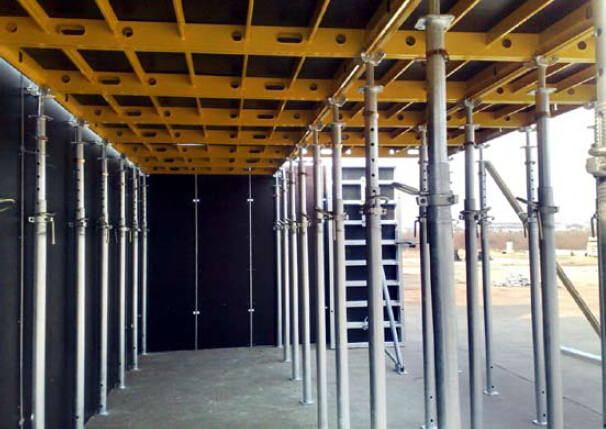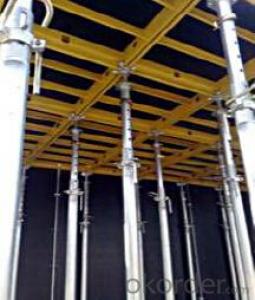Aluminum-frame for formwork and scaffolding system
- Loading Port:
- Tianjin
- Payment Terms:
- TT OR LC
- Min Order Qty:
- 50 m²
- Supply Capability:
- 1000 m²/month
OKorder Service Pledge
Quality Product, Order Online Tracking, Timely Delivery
OKorder Financial Service
Credit Rating, Credit Services, Credit Purchasing
You Might Also Like
Aluminum-frame Formwork
Characteristics:
◆ The complete formwork system for slab casting, easy & quick assembly.
◆ Light panel weight, easy to carry.
◆ Economical, versatile & hi-speed formwork system; comes with a permissible slab
thickness of 400 mm.
◆ Working efficiency is greatly improved by fast erection and dismantlement.
◆ The panel can be supported by both props and scaffolding.
◆ High standardization with components.


- Q:Can steel formwork be used for both straight and curved structures?
- Yes, steel formwork can be used for both straight and curved structures. It can be easily adjusted and shaped to accommodate various design requirements, making it versatile for construction projects that involve both straight and curved elements.
- Q:Can steel formwork be used for both monolithic and composite construction?
- Yes, steel formwork can be used for both monolithic and composite construction. Monolithic construction refers to the process of pouring concrete in a single continuous operation to form a solid structure. Steel formwork is commonly used in monolithic construction as it provides a strong and durable support system for holding the concrete in place until it sets and hardens. The steel formwork can be easily assembled and disassembled, making it efficient for monolithic construction projects. Composite construction, on the other hand, involves the combination of different materials to create a stronger and more efficient structure. Steel formwork can also be used in composite construction, especially when the concrete is combined with other materials such as steel beams or columns. The steel formwork acts as a mold for the concrete, allowing it to be poured and shaped around the other materials to create the desired structure. Overall, steel formwork is versatile and can be used in various construction methods, including both monolithic and composite construction. Its strength, durability, and ease of use make it a popular choice for contractors and builders in a wide range of construction projects.
- Q:How does steel formwork affect the overall stability of the structure?
- Steel formwork can greatly enhance the overall stability of a structure. Its rigid and durable nature provides strong support during the construction process, ensuring that the concrete is poured and cured accurately. This stability prevents any shifting or deformation of the structure, resulting in a more robust and long-lasting building. Additionally, steel formwork allows for precise alignment and dimension control, enabling the structure to meet the required design specifications, resulting in enhanced stability and structural integrity.
- Q:What are the common accessories used with steel formwork?
- Steel formwork commonly utilizes various accessories such as form ties, wedges, form release agents, formwork clamps, and form liners. Form ties play a crucial role in securing the formwork and maintaining its position throughout the concrete pouring and curing stages. They are typically constructed from steel and are available in different lengths and designs to accommodate diverse formwork needs. Wedges, typically composed of steel or plastic, are essential in conjunction with form ties to firmly secure the formwork. They are inserted into the form tie to provide a tight grip and ensure stability. Form release agents are applied to the formwork surface to prevent concrete from adhering to it. By creating a barrier between the concrete and formwork, they facilitate easy removal of the formwork after the concrete has cured. Formwork clamps, made of steel and offered in various sizes and designs, are used to hold the formwork panels together and maintain proper alignment during concrete pouring. Form liners, typically constructed from plastic or elastomeric materials, are attached to the formwork prior to concrete pouring. They enable the creation of decorative patterns or textures on the concrete surface. Upon the concrete's curing, the form liners are removed, leaving behind the desired appearance. These accessories are frequently employed in conjunction with steel formwork systems to optimize efficiency and effectiveness during the construction process, resulting in high-quality concrete structures.
- Q:How does steel formwork affect the overall construction site safety measures?
- Steel formwork can have a significant impact on the overall construction site safety measures in several ways. Firstly, steel formwork is known for its high strength and durability, which ensures stability and structural integrity during the construction process. This reduces the risk of accidents such as collapses or structural failures, enhancing the safety of workers and the site as a whole. Additionally, steel formwork offers better fire resistance compared to other types of formwork materials. This characteristic can prevent or slow down the spread of fire, providing extra time for workers to evacuate the site safely and for emergency services to respond effectively. It also reduces the risk of fire-related accidents, protecting both human lives and the surrounding environment. Another safety benefit of steel formwork is its ability to withstand extreme weather conditions, such as strong winds or heavy rain. This resilience reduces the likelihood of formwork damage or failure, ensuring the safety of workers and preventing potential accidents caused by adverse weather. Furthermore, steel formwork is often designed with built-in safety features, such as handrails and platforms, to provide secure working surfaces for construction workers. These features allow workers to perform their tasks safely at heights, reducing the risk of falls and injuries. Lastly, steel formwork is reusable and requires minimal maintenance, which contributes to the overall site safety. The use of reusable formwork reduces waste and clutter, creating a cleaner and more organized working environment. This, in turn, minimizes the risk of accidents caused by tripping or falling over debris. In conclusion, steel formwork positively affects the overall construction site safety measures by providing stability, fire resistance, weather resistance, built-in safety features, and a cleaner working environment. These benefits reduce the risk of accidents, ensure the safety of workers, and contribute to the successful completion of construction projects.
- Q:Can steel formwork be used in cultural or entertainment facility construction projects?
- Cultural or entertainment facility construction projects can indeed utilize steel formwork. This type of formwork possesses various advantages, including durability, strength, and the ability to withstand heavy loads. These characteristics make it a suitable choice for constructing the large and intricate structures commonly found in cultural and entertainment facilities, such as theaters, concert halls, museums, and stadiums. Furthermore, steel formwork can be easily tailored to meet the specific design requirements of these facilities, thereby offering flexibility and efficiency during the construction process. Additionally, the reusability of steel formwork contributes to cost savings and a reduced environmental impact. In conclusion, considering its strength, durability, flexibility, and cost-effectiveness, steel formwork presents itself as a viable option for cultural or entertainment facility construction projects.
- Q:What are the different types of steel formwork ties and connectors?
- In construction projects, various types of steel formwork ties and connectors are utilized. These ties and connectors play a vital role in securing and linking formwork panels, ensuring the stability and strength of the concrete structure under construction. 1. Snap Ties: Among the frequently employed formwork ties are snap ties. They comprise two components - a metal rod and a flat metal plate. The rod is inserted through the formwork panels and then snapped onto the plate, effectively holding the panels in place. 2. Wedge Ties: Another popular formwork tie option is wedge ties. They consist of a metal rod with a wedge-shaped end and a flat metal plate. The rod is inserted through the formwork panels, and the wedge is driven into a slot on the rod, creating a tight connection between the panels. 3. Loop Ties: Loop ties find common usage in situations where the formwork panels require easy adjustability or repositioning. They consist of a metal rod with a loop at one end and a flat metal plate at the other. The loop is inserted through the formwork panels, and the rod is bent to secure the panels together. 4. Flat Ties: Similar to snap ties, flat ties lack a snap mechanism. They are comprised of a flat metal plate with holes for inserting a metal rod. The rod is inserted through the formwork panels, and the flat tie is secured by twisting the rod or using a locking device. 5. Tie Rods: Tie rods work in conjunction with various formwork ties to provide additional strength and stability. These lengthy steel rods are inserted through the formwork panels and secured with nuts and washers on both ends. 6. Formwork Clamps: Formwork clamps serve as connectors to join and align formwork panels. Typically made of steel, they feature adjustable screws or bolts to tighten and secure the panels together. 7. Combi Nuts: Combi nuts are utilized in combination with tie rods and formwork clamps to connect and tighten formwork panels. They possess a threaded hole that allows the tie rod to pass through and secure the panels. These represent some of the prevalent forms of steel formwork ties and connectors found in construction projects. The appropriate type is selected based on factors such as the formwork system in use, load requirements, and the specific needs of the project.
- Q:How does steel formwork affect the overall project timeline?
- Steel formwork can have a positive impact on the overall project timeline. Its durability and reusability allow for faster and more efficient construction processes, reducing the time required for formwork installation and removal. Additionally, steel formwork often requires less maintenance and repairs compared to traditional wooden formwork, minimizing potential delays caused by formwork issues.
- Q:What are the considerations when designing steel formwork for stairs?
- When designing steel formwork for stairs, several important considerations need to be taken into account. Firstly, the structural integrity and load-bearing capacity of the formwork must be carefully evaluated to ensure it can support the weight of workers, materials, and any equipment used during the construction process. Additionally, the formwork should be designed to provide sufficient stability and rigidity to prevent any deformation or movement during concrete pouring and curing. The dimensions and shape of the stairs, including the riser and tread dimensions, should be accurately calculated to meet safety and accessibility standards. Lastly, attention should be given to ease of assembly, disassembly, and reusability of the formwork to optimize efficiency and cost-effectiveness in construction projects.
- Q:What are the different types of steel alloys used in formwork manufacturing?
- There are several types of steel alloys commonly used in formwork manufacturing, including carbon steel, stainless steel, and high-strength low-alloy (HSLA) steel. Each alloy has its own unique properties and advantages, making them suitable for different applications in formwork construction.
1. Manufacturer Overview |
|
|---|---|
| Location | |
| Year Established | |
| Annual Output Value | |
| Main Markets | |
| Company Certifications | |
2. Manufacturer Certificates |
|
|---|---|
| a) Certification Name | |
| Range | |
| Reference | |
| Validity Period | |
3. Manufacturer Capability |
|
|---|---|
| a)Trade Capacity | |
| Nearest Port | |
| Export Percentage | |
| No.of Employees in Trade Department | |
| Language Spoken: | |
| b)Factory Information | |
| Factory Size: | |
| No. of Production Lines | |
| Contract Manufacturing | |
| Product Price Range | |
Send your message to us
Aluminum-frame for formwork and scaffolding system
- Loading Port:
- Tianjin
- Payment Terms:
- TT OR LC
- Min Order Qty:
- 50 m²
- Supply Capability:
- 1000 m²/month
OKorder Service Pledge
Quality Product, Order Online Tracking, Timely Delivery
OKorder Financial Service
Credit Rating, Credit Services, Credit Purchasing
Similar products
New products
Hot products
Hot Searches
Related keywords
























